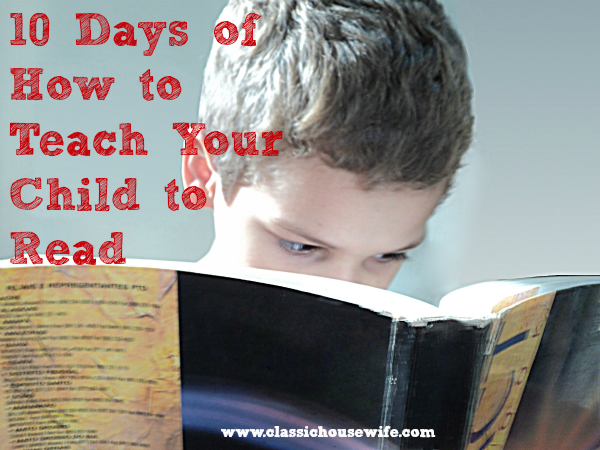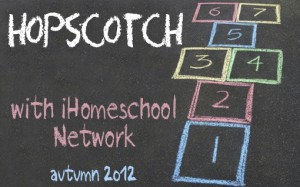Ten Days of How to Teach Your Child to Read
The one and only education class I took in college (before switching to a different major, which I also never finished) was a class about the fundamentals of reading. I remember thinking, “what’s the big deal? Is it really that hard to teach reading?” Fast forward a dozen years or so and I find myself teaching my own children to read, discovering that sometimes it is and sometimes it isn’t. Why is it that something we all take for granted is so scary for many of us to teach?
Perhaps we worry because reading is so foundational for the rest of our learning. Maybe we are afraid that if our children don’t thrive and love reading “on time” then it will reflect badly on us – or worse, actually BE our fault! Relax! You can do this. Over the next two weeks we will be diving into the hows and whys of reading so that you can feel confident teaching your struggling or learning readers, opening them up to the world of the written word.
Reading Readiness
One of the first questions parents ask is, “How do I know if my child is ready?” Honestly? There is no set number. I know, helpful, right? However, there *are* signals that your child is ready to read. Most children learn to read around age 5, but some begin as early as 2 or 3 and many wait until 6 or 7. Truly, the best answer is to watch your child. They will let you know.
What signals can you watch for? Signs of reading readiness include:
- Recognizing the marks on the page as “words” and understanding that they hold meaning.
- Recognizing individual letters and knowing some or all of their sounds.
- Attempting to write the letters, attempting to put letters together into words (they may or may not make sense.)
- Asking how to read or write/spell something.
- Pretending to read to others or toys, pretending to write (also may or may not make sense.)
- Holding a book right side up and turning pages from right to left correctly.
- Holding a familiar book and pretending to read it (but recalling it from memory.)
- Guessing what comes next in the story based on the pictures and the context clues.
- Recognizing some words such as their name or familiar places (your church name on the church bulletin, the fast food restaurant name on the to go cup.)
- Recognizing and making rhymes.
- Listing words that begin with the same sound as a starting word (bat, ball, bag, big, etc.)
Of course, your child may have all of these signs and still may not be ready to learn to read. The biggest signal is a sign of desire and willingness to sit down and try. Every child is different; my three children are no exception. I don’t believe in pushing them to read because I don’t want them to pull away from the reading process. I want my kids to love reading, or at least not hate it, and I don’t want to make learning how to do it so miserable that they never want to read on their own. If your child desires to learn to read, whether they are two or seven, then the time is right.
So what is “Pre-Reading?”
Simply put, pre-reading is everything you need to know before you can actually read. Much of what you find on the Reading Readiness list is a part of the pre-reading process. Knowing the letters and their sounds, knowing to read left to right, how to hold the book, recognizing words and sentences.. these are all a part of pre-reading. This is the phase in which the child is getting ready to read, is gathering the knowledge he needs and learning how to put the pieces together. The question is, how long will a child hang out in pre-reading before they are ready to make the jump into reading?
My son is an example of a child who wanted to “hang out” in pre-reading for a while. By two he knew all of his letters and their sounds and could write most of them. He pretended to read and write by age three. He loved being read to, knew how to hold a book, recognized some names, and could make rhymes. For a little while it looked like he might actually be an early reader. But he wasn’t ready. He would get frustrated with trying to read sentences and books and readers and he would put the mental brakes on. So I would back off. But while he may not have looked like he was “learning,” he was. He was learning to read words on signs, he was sounding out words and writing them on his papers, he was learning at his own pace in a hands on kind of way. Over the past year he finally grew to a point of readiness for instruction and I was amazed at what he already knew. At almost 7, he still doesn’t like to sit down for reading instruction, but that’s okay.
Our task as parents is to know when and how to help our children cross the bridge from pre-reading into reading. It doesn’t happen overnight. And sometimes the transition isn’t immediately obvious. The journey may even be filled with difficulty and struggles. But the confidence our children gain when it finally clicks makes it all worth it. Until your child makes that transition, there are some things that you can do to help.
Ten Things You Can Do To Help Your Pre-Reading or Struggling Child
- Don’t worry. Children read when they are ready, when supplied with opportunity and patient instruction. There is no rush.
- No comparing. Every child is different!
- Don’t push. Pushing may create a negative mindset that hinders their interest and willingness to learn.
- DO read to them. Good stuff. As much as you can. Create interest in the stories we can discover inside the pages of a book so they might want to discover them on their own.
- DO provide books at their skill level (alphabet, simple words, simple sentences) for them to look at whenever they will.
- DO point out written words throughout your day, outside of an instructional setting – “PUSH” on the door, “ON” on the remote, etc.
- DO play rhyme games, and “words that start with the letter __” games, etc.
- Do encourage them to sit and read very short “lessons” at their skill level (letters or short words, etc.) with you as often as possible, quitting when they get frustrated, and praising them for good work.
- Do consider their learning styles and what games or approaches they may find most appealing.
- Don’t forget: When we worry or our child refuses to cooperate or we just don’t know what to do–pray!
Get Ready!
Helping your child through pre-reading is just the first step in the process. Maybe you’ve already passed through and are actively in the instruction phase. In either case, I’m going to be addressing a variety of topics in this ten day series. Here’s the plan (I’m going to come back and hyperlink each of these as they go live.)
- Reading Readiness / Pre-Reading (this post.)
- Approaches to Instruction
- Teaching with Readers
- Teaching with Word Families
- Struggling Readers
- Teaching a Visual Learner
- Teaching a Kinesthetic Learner
- Teaching an Auditory Learner
- Inspiring & Encouraging a Love of Reading
- Free Reading Resources
Further reading: Get Your Preschooler Ready to Read on Scholastic.com; Pre-Reading Skills at Time4Learning.com; How to Enhance Pre-Reading Skills at How.com
What questions do you have about reading readiness and pre-reading? Leave them in the comments below. Feel free to answer other questions and encourage each other.
This series is a part of a blog hop called “The Hopscotch” through iHomeschool Network (previously known as “the ten days of” series.) HOP on over and hopscotch through all the other 10 Days series. While you’re there, check out the Pin it to Win It contest featuring a giveaway of products from Prufrock Press.
If you’d like to read more posts related to reading, then you may want to check out Marianne’s Homeschooling with Dyslexia, Mary’s 10 Days of Reading Aloud, or Becky’s Teaching Spelling Through Word Study!
Image Source: Young Reader by Francisco Farias Jr



I love this post, Amber. I especially like the list of tips for struggling readers. It is so right on. Exposure, fun, enjoying the printed word. If you can capture their imagination and sense of fun, you’ve got ’em! Thanks for posting.
Thank you for the article! I really needed to hear the “don’t worry” part.
[…] Just joining in? Start at the beginning. (It’s a very good place to start.) […]
[…] Just joining in? Start at the beginning. (It’s a very good place to start.) […]
[…] Just joining in? Start at the beginning. (It’s a very good place to start.) […]
[…] Just joining in? Start at the beginning. (It’s a very good place to start.) […]